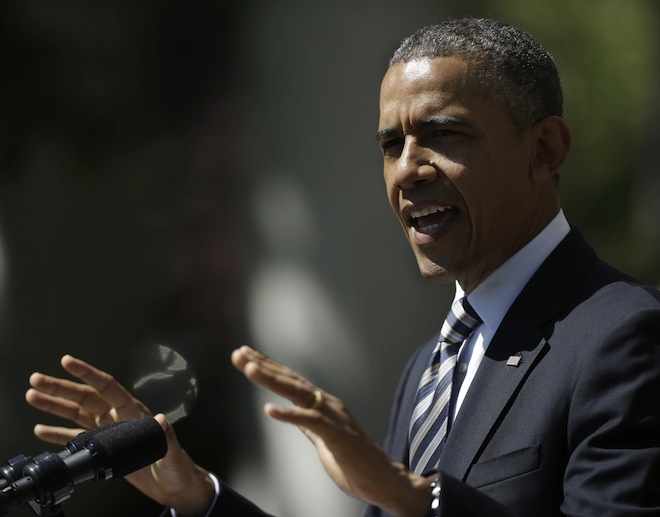President Obama escalated his fight with Republicans on the issue of student loans Friday, ripping into their proposed policy to avert a scheduled spike in interest rates on July 1.
“The House of Representatives has already passed a student loan bill, and I’m glad that they took action, but unfortunately their bill does not meet that test,” Obama said during a nationally televised speech in the White House Rose Garden, flanked by college students. “The House bill is not smart, and it is not fair. … They did not do it in the right way.”
In 2007, Congress froze federally-subsidized student loan interest rates at 3.4 percent, separating it from market forces. Last year, that rate was set to double to 6.8 percent, but under pressure from Obama in the heat of the campaign, Congress extended the low rate for one year. Now the issue has come back, with rates set to double again in July.
The Obama and GOP plans are conceptually similar in that they tie loan interest rates to the yield on 10-year Treasury bills. Student activists and education policy experts say students would likely pay higher interest rates over time under both proposals.
But there are differences. Compared to the House GOP plan, Obama’s plan would lead to rates 1.57 percent lower for subsidized Stafford loans, and about 0.57 percent lower for PLUS loans. And unlike the GOP plan, the White House plan also limits repayments to 10 percent of a borrower’s discretionary income and fixes the rate for the life of the loan. The GOP plan includes a cap on Stafford loan rates at 8.5 percent; the White House plan has no cap.
“I don’t think they’re very far apart, honestly,” Beth Akers, a fellow and education policy expert at the Brookings Institution, told TPM.
But Obama, seeking to press his large advantage with younger voters, has threatened to veto the GOP’s House-passed legislation regardless. He stressed the differences Friday.
“It fails to lock in low rates for students next year,” Obama said of the GOP bill. “That is not smart. It eliminates safeguards for lower income families. That is not fair.”
House Speaker John Boehner (R-OH) quickly responded to Obama, arguing that the differences between the White House and GOP plans “are small, and there’s no reason they cannot be overcome quickly. But today, rather than working to resolve the issue, the president resorted to a campaign stunt to try to score political points.” As Obama was speaking, House GOP leadership aides took to Twitter to highlight the reported similarities between the two proposals.
Democrats are using the occasion to try and damage the GOP’s credibility even further among college-age students. House Democrats’ campaign arm announced a plan to run print and online ads at newspapers on six college campuses in Republican-held districts.
“For the umpteenth time, House Republicans are ignoring the needs of middle class families and standing with corporate special interests,” said Emily Bittner of the Democratic Congressional Campaign Committee.
The president drew upon his personal experience, saying Friday that he and First Lady Michelle Obama didn’t finish paying off their student loans until about nine years ago.
“We cannot price the middle class or folks who are working hard to get out of the middle class out of a college education,” he said. “We cannot keep saddling young people with more debt just as they are starting out in life.”










